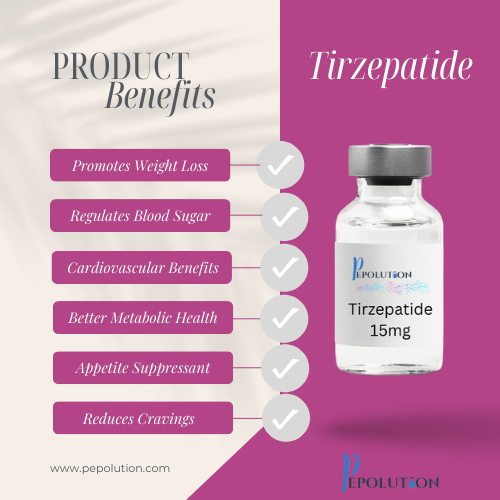What is Tirzepatide?
You may have heard of the prescription medications Zepbound or Mounjaro. Both of these drugs have the same active ingredient – Tirzepatide, which is a synthetic peptide. The difference between them lays in what conditions they are approved to treat. For Zepbound, weight loss is the targeted objective, while Mounjaro is for treatment of Type 2 diabetes. Tirzepatide is the first dual GLP-1 and glucagon-like peptide 1 (GIP) receptor agonist, and has shown in research studies to show significant beneficial effects like lowering blood sugar, improving blood pressure and most of all, weight reduction. It is the It is injected once weekly in the stomach, thigh or upper arm.
Tirzepatide acts as both a GLP-1 and a GIP receptor agonist, mimicking hormones that naturally secrete from the digestive tract after a meal. These hormones trigger insulin secretion, slow stomach emptying and signal to the brain that you’re full. Tirzepatide also works to regulate fat cells and suppress appetite.
As with any weight loss or wellness tool, Tirzepatide works best when combined with lifestyle changes. It can help reduce appetite and suppress cravings, which really helps individuals maintain a healthy calorie deficit. Many users report less “food noise,” meaning they find themselves thinking less and less about food. Additionally, it can help boost metabolism, which allows the body to burn more calories at rest.
Benefits of Tirzepatide:
- Promotes Weight Loss
- Regulates Blood Sugar
- Cardiovascular Benefits
- Better Metabolic Health
- Appetite Suppressant
- Reduces Cravings
- Amplifies Effects of Lifestyle Changes
How do you use Tirzepatide?
Tirzepatide is administered as a weekly subcutaneous injection into the abdomen, thigh or arm. It’s typically titrated, meaning that you start with a low dose and increase it at four-week intervals. Many individuals stay on the lower dose until weight loss stops or stalls, and then titrate up. Tirzepatide dosages are 2.5mg, 5mg, 10mg, 12.5mg and 15mg.
Research on Tirzepatide
One study of the Tirzepatide peptide was the GO-ITTib study, a phase 3 clinical trial that included a 36-week open-label Tirzepatide lead-in period and a 26-week double-blind placebo-controlled treatment period. Primary objective measures were changes in fasting visual analog scale (VAS) ratings of hunger, satiety, and fullness and prospective food intake at baseline and weeks 8, 16, and 28. Energy intake was measured during a buffet-style, ad libitum lunch. Results showed a statistically significant reduction in overall energy intake (food ingested) with both Tirzepatide and Semaglutide compared to placebo.
In the SURPASS 1-4 clinical trials, randomized participants treated with Tirzepatide experienced an average weight loss of 20.9 percent over 36 weeks. This weight loss was not the only benefit – there was also marked improvements in glycemic metrics, blood pressure and lipids.
In a new study, published in the journal Hypertension, researchers found that Tirzepatide significantly lowers blood pressure in people with diabetes and obesity. Using ambulatory blood pressure monitoring (ABPM), which measures blood pressure every 30 minutes during the day and 60 minutes at night over a 24- to 27-hour period, participants in the study who were randomized to Tirzepatide or placebo showed that their systolic blood pressure (the top number in a BP reading) decreased more than with the placebo.
These results are the latest evidence that GLP-1 receptor agonists, like Tirzepatide can improve cardiometabolic conditions that are often associated with diabetes and obesity. At 36 weeks, each Tirzepatide dose significantly lowered systolic BP and diastolic BP compared with placebo.
SUMMARY
Tirzepatide is a synthetic peptide that acts as both a glucagon-like peptide-1 (GLP-1) and glucose-dependent insulinotropic polypeptide (GIP) receptor agonist. As a result, it reduces appetite and slows down digestion, helping people feel full after eating, leading to weight loss. It also lowers blood sugar levels and improves glycemic control in people with diabetes.
Because of the way this peptide works, some things to watch out for are diarrhea or constipation, nausea and vomiting, heatburn, stomach pain, burping, or gas. Most people report these side effects as being mild, and normally go away after their body adjusts to the peptide.
A significant percentage of people taking 10 mg or 15 mg of Tirzepatide achieved at least a 35% body weight reduction compared to 5% in the placebo group. Similar dose-response patterns were seen with improvements in systolic blood pressure and other prespecified cardiometabolic measures.
Insurance coverage for Mounjaro or Zepbound varies significantly among insurance plans. Many will not cover either one, or have very high co-pays. You can check your insurance plan’s formulary to see if they are covered. If insurance is not an option, peptides through compounding pharmacies with a valid prescription. Lastly, online peptide suppliers are available for research and development purposes. If you are looking to conduct your own research, find a vendor that you trust. Products should be independently tested for purity and strength.
The best play to buy peptides online – Pepolution of course! Your best source for research peptides online. If you are interested in connecting with other individuals conducting their own research, or have questions, join the private group on FACEBOOK HERE.



